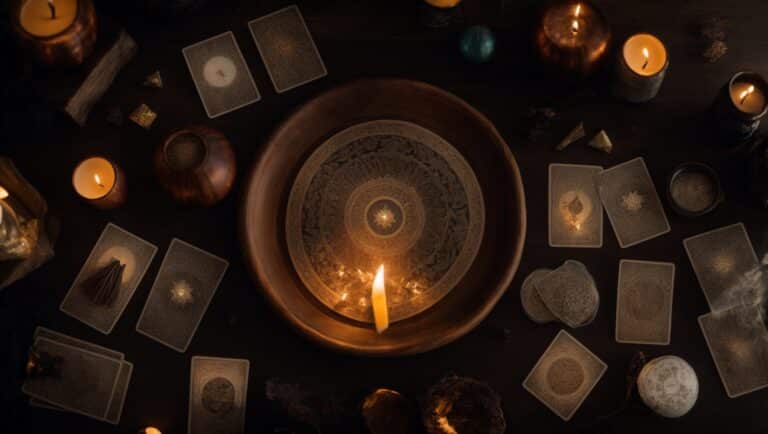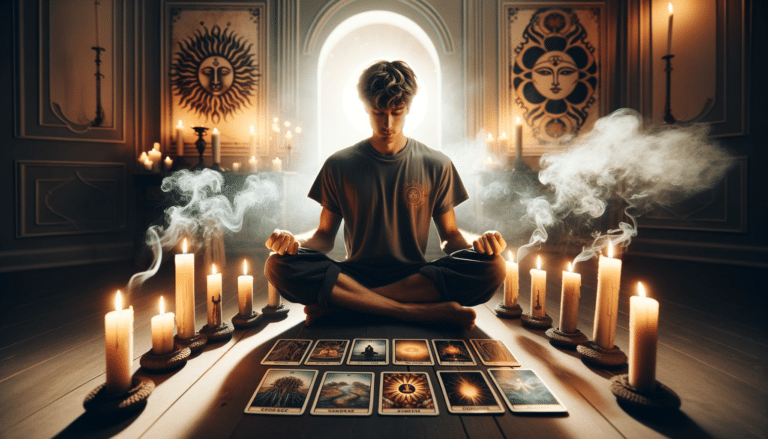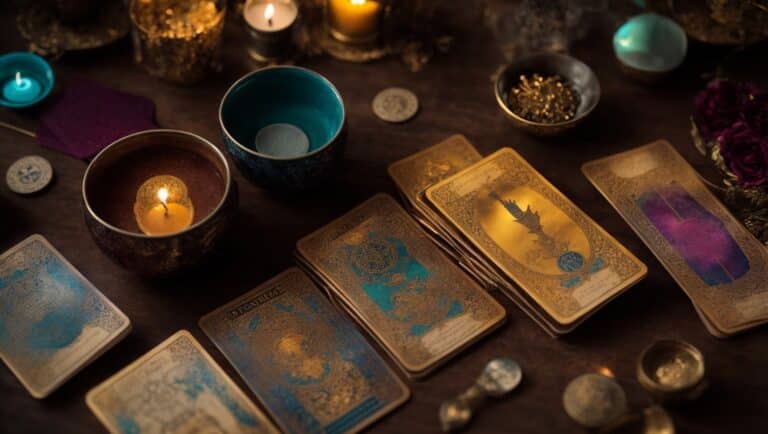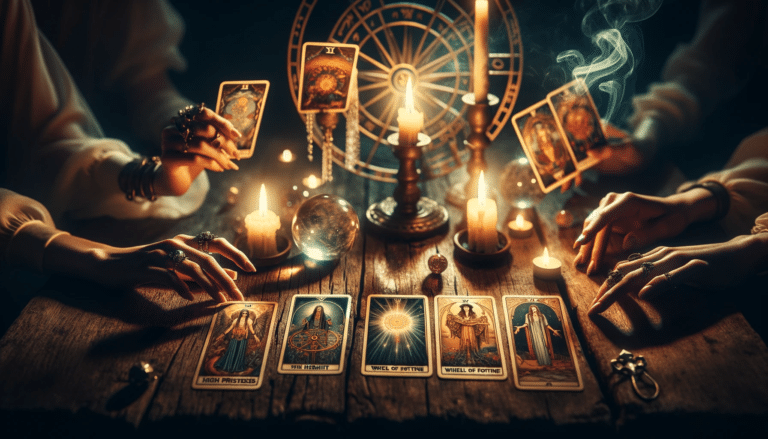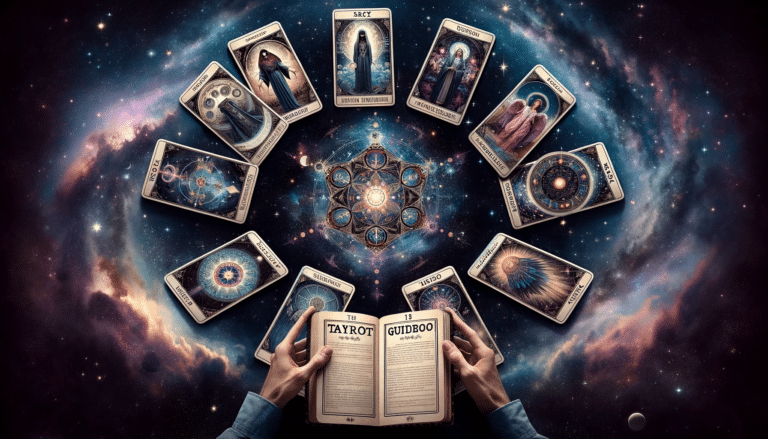Learn Tarot Card Symbol Interpretation: A Comprehensive Guide
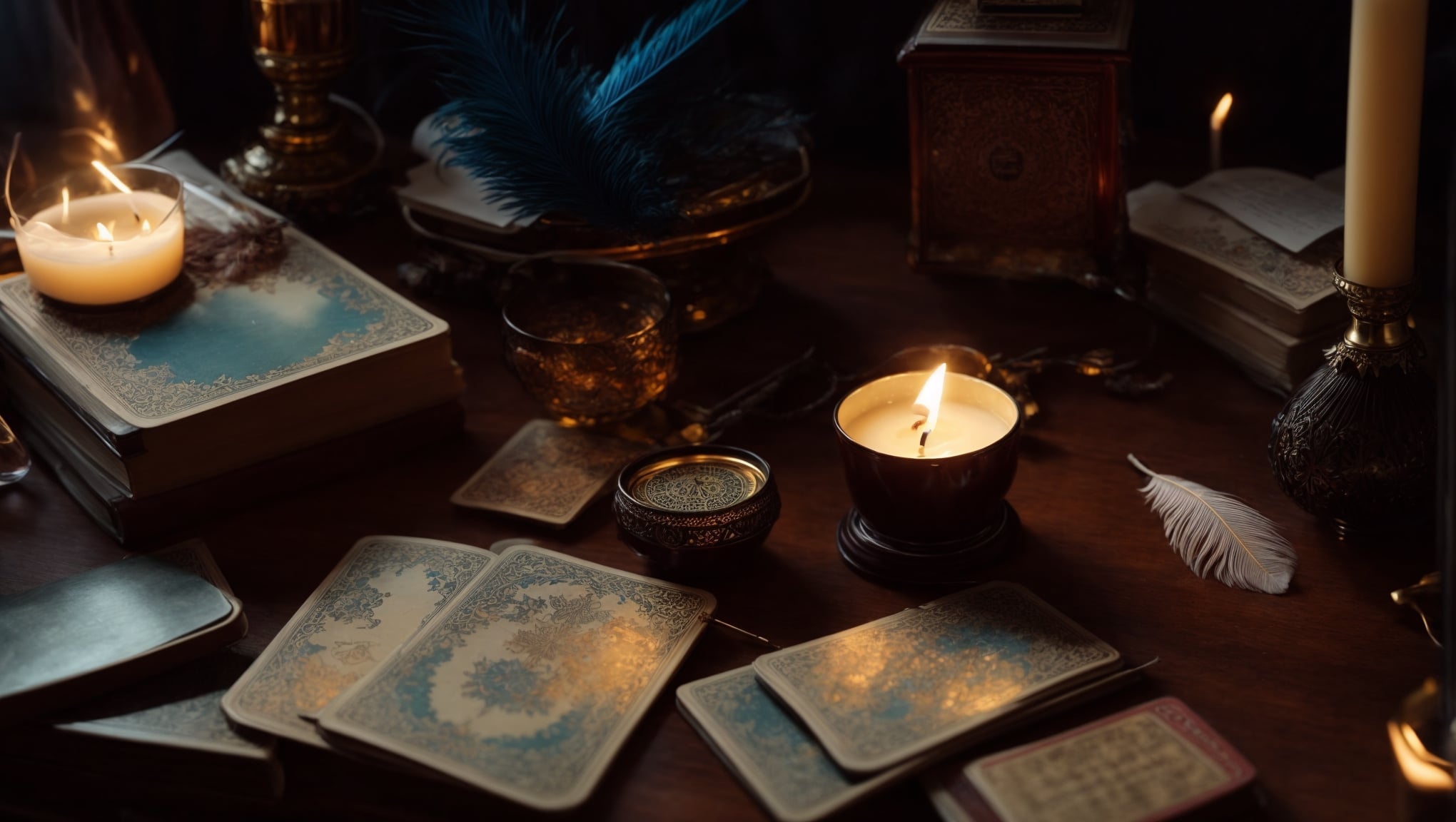
Did you know 3 out of 4 readers struggle with tarot card symbol interpretation?
In this guide, you’ll uncover the secrets of how to learn tarot card symbol interpretation, enhancing your intuition and decoding the mysteries of Major and Minor Arcana. I’ve packed it with practical tips to help you master your next reading.
So, don’t worry… You’ve got this, and I’m here to guide you every step of the way.
Let’s dive in!
Key Takeaways
- A standard tarot deck consists of 78 cards divided into the Major Arcana and the Minor Arcana.
- The Major Arcana consists of 22 cards representing life’s karmic and spiritual lessons.
- The Minor Arcana consists of 56 cards divided into four suits: Cups, Pentacles, Swords, and Wands.
- Each suit in the Minor Arcana represents a specific aspect of life: Cups for emotions, Pentacles for the physical world, Swords for thoughts, and Wands for energy.
Understanding Tarot Card Basics
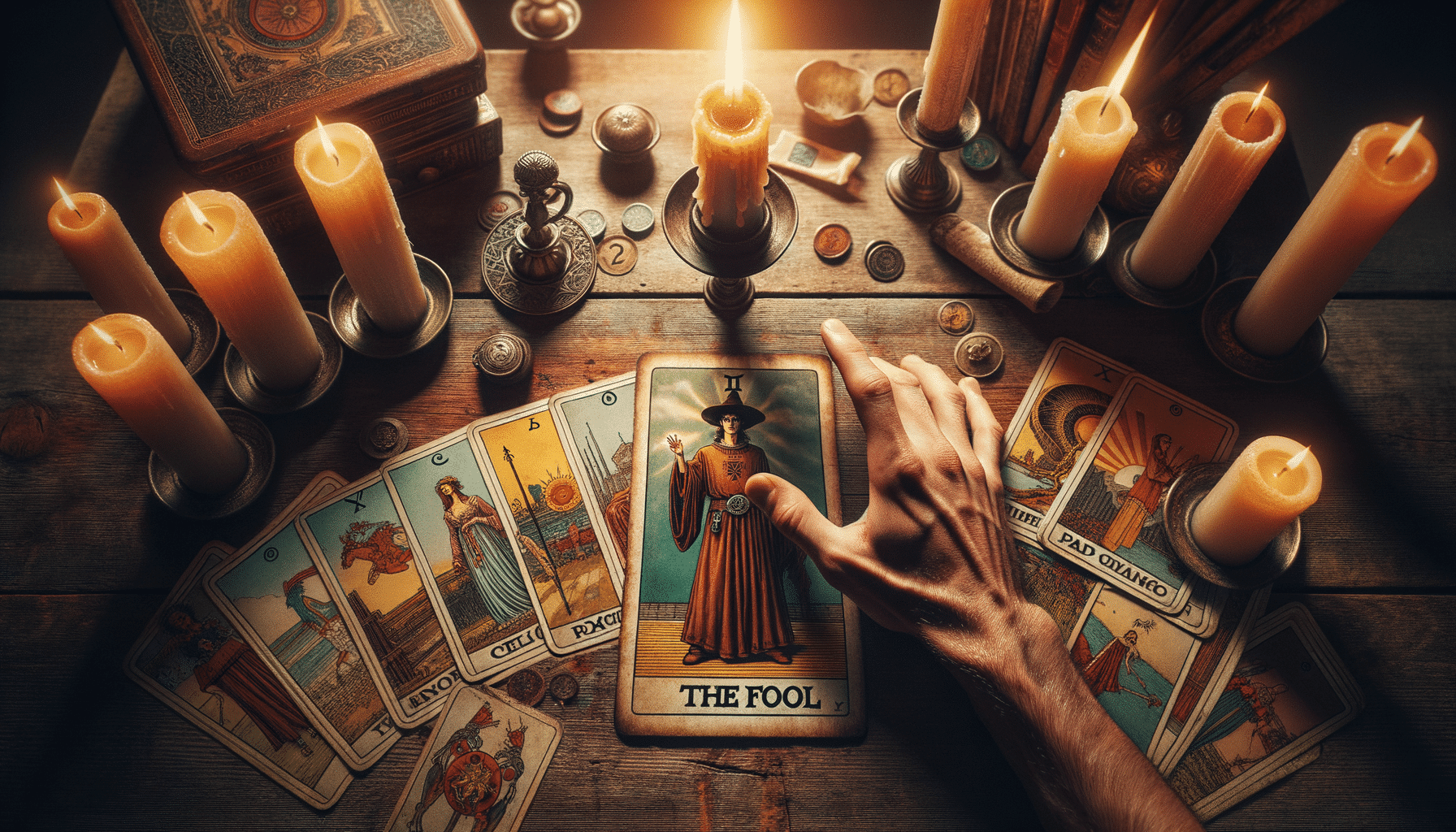
Before delving into the art of tarot card symbol interpretation, you’ll need to grasp the basics of tarot cards themselves. You see, a standard tarot deck is composed of 78 cards, each teeming with rich symbolism and imagery. These cards are divided into two main groups: the Major Arcana and the Minor Arcana.
The Major Arcana, often called the trump cards, consists of 22 cards. Each card represents life’s karmic and spiritual lessons, and they’re more concerned with the big issues of life rather than the everyday ups and downs.
On the other hand, you’ve got the Minor Arcana. This portion holds 56 cards divided into four suits: Cups, Pentacles, Swords, and Wands. Each suit speaks to a specific aspect of life. Cups deal with emotions, relationships, feelings. Pentacles are about our physical, material world. Swords tackle our thoughts, attitudes, and beliefs. Wands, finally, are about our energy levels, passion, and drive.
Check out our Tarot Cards & Oracle Decks here…
Deep Dive Into Tarot Symbolism
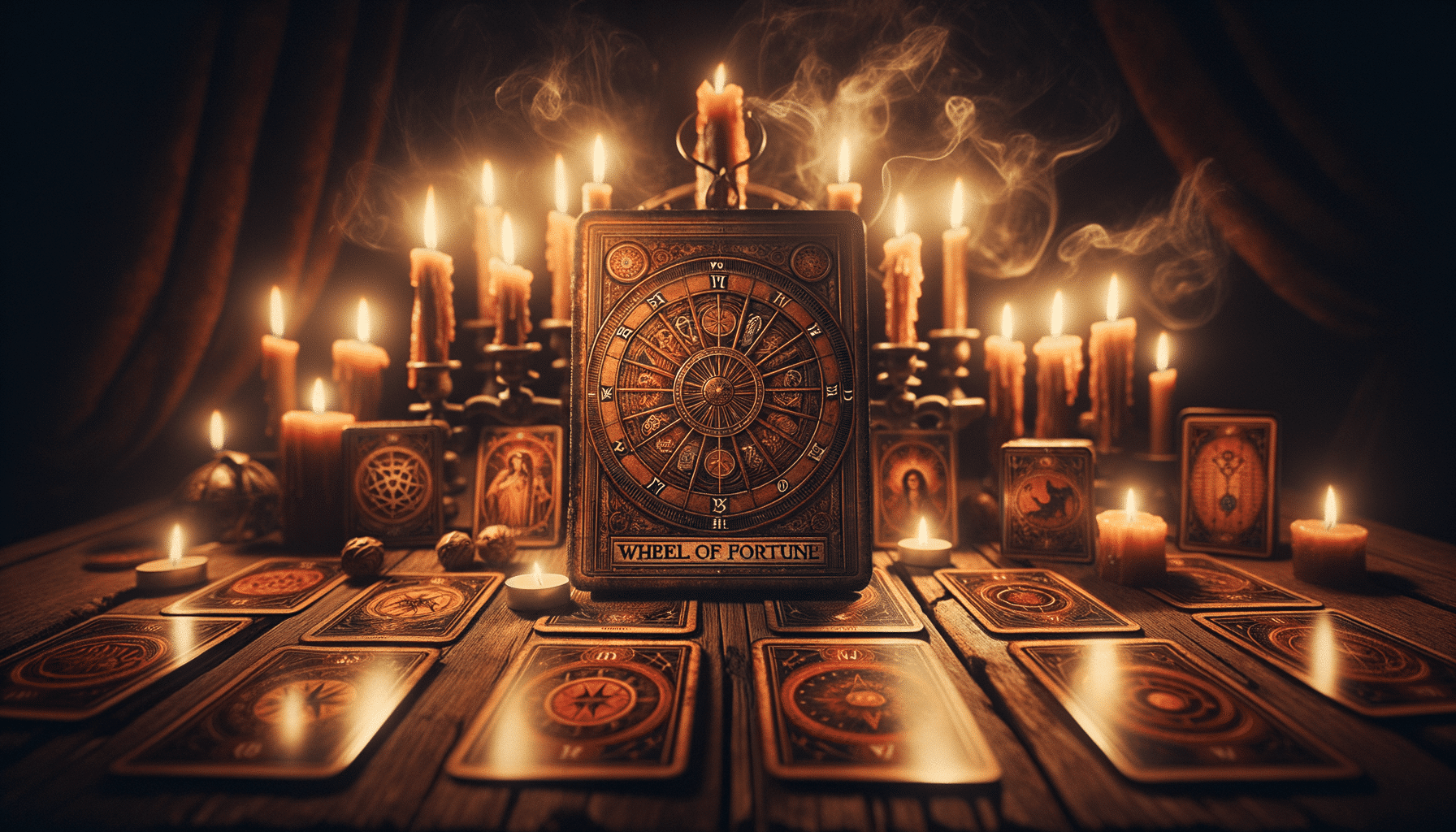
Now that you’re familiar with the basics, let’s dive deeper into the rich symbolism that each tarot card holds. Each card is a treasure trove of symbols, colors, and numbers, each with its own unique meaning.
For example, in the Rider-Waite deck, the Magician card shows a man with an infinity symbol above his head and various tools on a table. The infinity symbol represents infinite possibilities and the tools signify the different elements: pentacles for earth, sword for air, cup for water, and wand for fire.
The Death card, often feared, isn’t about physical death but symbolic death and transformation. The rising sun in the background symbolizes a new beginning after an end. The Hierophant, with his hand raised in blessing, conveys spiritual wisdom and guidance.
Colors also have meanings. Red signifies passion and energy, blue portrays intuition and emotion, and green represents growth and abundance. Numbers, too, carry significance. One stands for beginnings, two for balance, three for growth, and so forth.
Mastering tarot card symbolism isn’t just about memorizing meanings. It’s about understanding the complex tapestry of symbols and their interplay, which can unveil profound insights.
Learn about more Tarot Card Basics here…
Enhancing Intuition for Symbol Interpretation
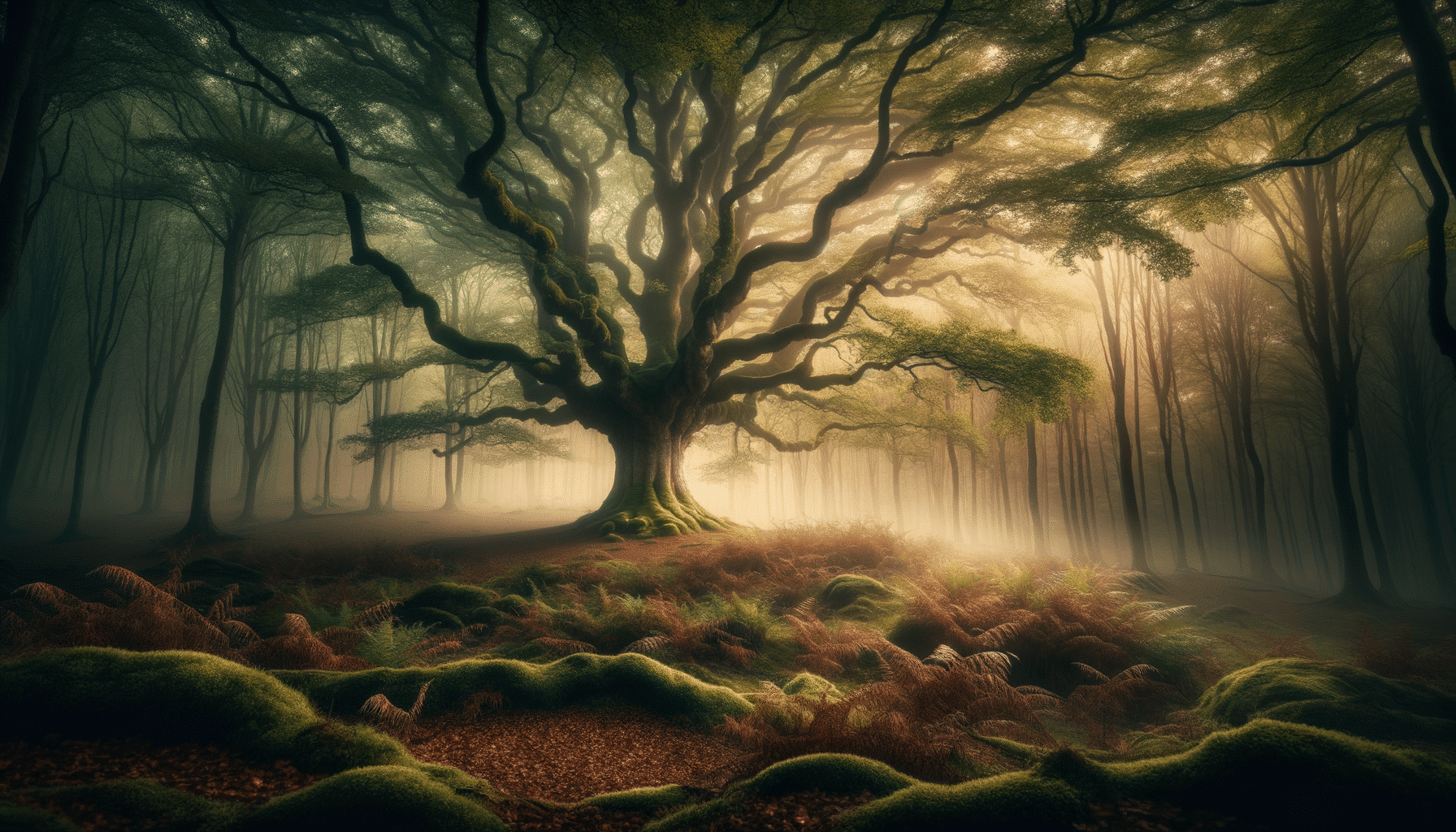
So, how can you refine your intuition to more effectively interpret the complex symbolism in tarot cards? It’s about practicing consistently and opening your mind to different perspectives. Over time, you’ll develop a sharper intuitive sense, enabling you to delve deeper into the cards’ meanings.
Here are some techniques to enhance your intuition:
-
Meditation: This helps clear your mind, enabling you to focus and connect better with your intuition. Daily practice will strengthen this connection.
-
Journaling: Pen down your thoughts, feelings, and impressions about each card. This practice will help you identify patterns and insights that your intuition might be nudging you towards.
-
Spending time with your deck: Familiarize yourself with each card, its symbols, and meanings. The more time you spend, the more intuitively you’ll understand them.
Learn even more secrets of Tarot Card Interpretation here…
Role of Major Arcana in Interpretation
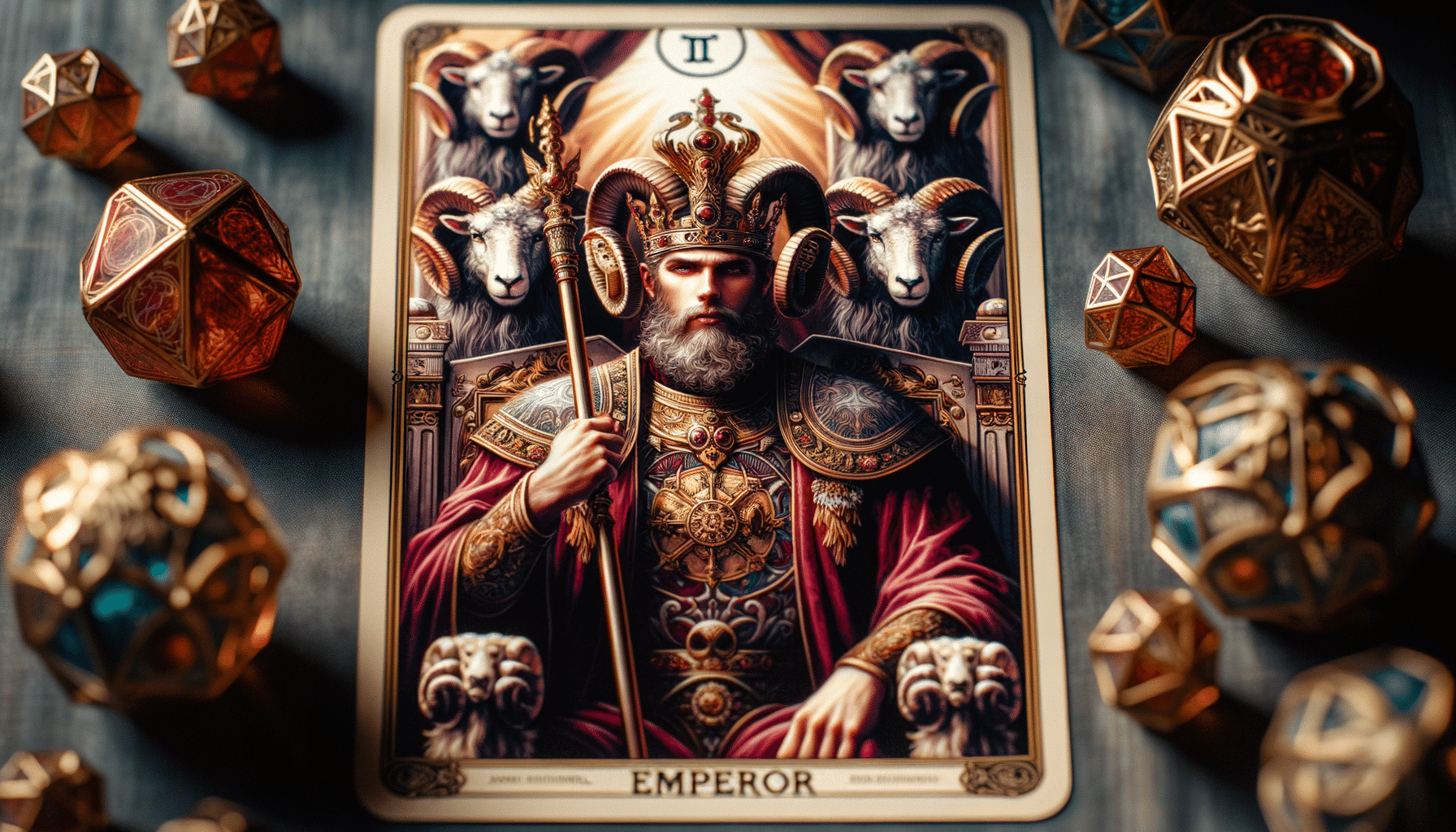
Why does the Major Arcana matter in your journey to master tarot card symbol interpretation? Well, it’s pivotal due to the profound wisdom it embodies. The Major Arcana consists of 22 cards, each signifying life’s significant events and spiritual lessons. They’re the backbone of the tarot deck, providing deep insights into life’s complexities and human nature.
When you draw a Major Arcana card in a reading, it’s a signal to pay attention. These cards represent substantial shifts, personal development, and important life lessons. They’re not about the daily ups and downs, but rather, the grand themes and profound shifts shaping your life’s journey.
Interpreting the Major Arcana involves understanding the symbolic language each card speaks. For instance, ‘The Fool’ represents beginnings and potential, while ‘The Death’ symbolizes transformation and change. These cards are mirrors, reflecting your soul’s deepest desires and challenges.
Mastering the interpretation of these cards can provide clear guidance in tumultuous times. They’re the guideposts illuminating your path, helping you navigate life’s journey with wisdom and understanding. So, give them the consideration they deserve. Your tarot reading’s depth and accuracy hinge on your grasp of the Major Arcana’s symbols and meanings.
Decoding Minor Arcana Symbols
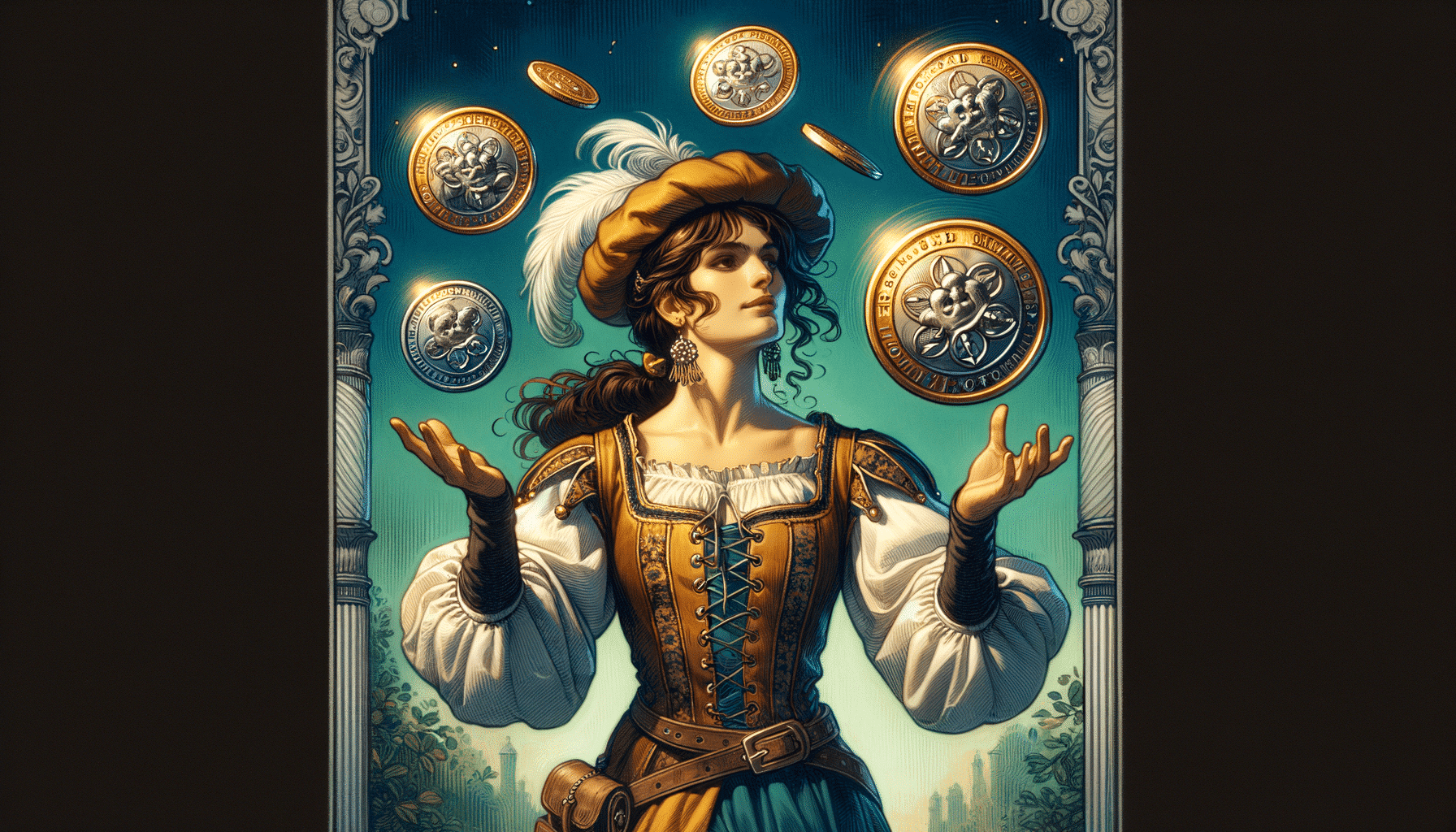
Now, let’s tackle the mystery of the Minor Arcana symbols in tarot.
You’ll find that understanding suit elements, deciphering number symbolism, and recognizing court cards are crucial in mastering this art.
Understanding Suit Elements
In your journey to decode the symbols of Minor Arcana, it’s crucial to comprehend the elements associated with each suit. Each suit in the Minor Arcana corresponds to a specific element: earth, fire, air, or water. These elements aren’t just randomly assigned; they’re deeply connected to the meaning and interpretation of each card.
-
Earth (Pentacles): Earth signifies material aspects of life and physicality. It’s the grounding force that helps us navigate our tangible world.
-
Fire (Wands): Fire symbolizes passion, energy, and initiative. It’s the spark that fuels our desires and aspirations.
-
Air (Swords): Air represents the realm of thoughts, communication, and intellect. It’s the breath of life that fuels our mental capacities.
-
Water (Cups): Water encompasses emotions, intuition, and relationships. It’s the ebb and flow that shapes our emotional landscape.
Understanding these elements can deepen your tarot reading skills and enhance your intuitive capabilities.
Number Symbolism
While you’re getting a handle on the elemental associations of each suit, it’s equally important to grasp the symbolism behind the numbers in Minor Arcana. The numbers one through ten carry a potent significance, each number representing a unique energy or concept.
For example, one often stands for beginnings, while ten can signify completion. Two often symbolizes partnerships, and three stands for growth. It’s essential to remember these meanings as you interpret the cards, as they add richness and depth to your readings.
By combining the suit’s element with the card’s numeric value, you can decipher a tarot card’s message with greater accuracy.
Now that you’re familiar with number symbolism, let’s move onto recognizing court cards.
Recognizing Court Cards
Understanding the court cards – King, Queen, Knight, and Page – in the Minor Arcana isn’t just about knowing their rank; it’s about decoding the profound symbols they hold.
-
King: Represents authority, control, and paternal influence. This card’s symbols often include a throne, scepter, or crown, indicating leadership and power.
-
Queen: Symbolizes intuition, understanding, and nurturing energy. Her symbols, like flowers and water, hint at emotional depth and wisdom.
-
Knight: Portrays action, adventure, and bravery. Look for symbols like horses and weapons, suggesting speed and courage.
-
Page: Embodies curiosity, potential, and youthful enthusiasm. The page’s symbols, such as scrolls or budding flowers, denote learning and growth.
As you grow confident recognizing and interpreting these symbols, let’s move onto some practical tips for mastering tarot reading.
Practical Tips for Mastering Tarot Reading
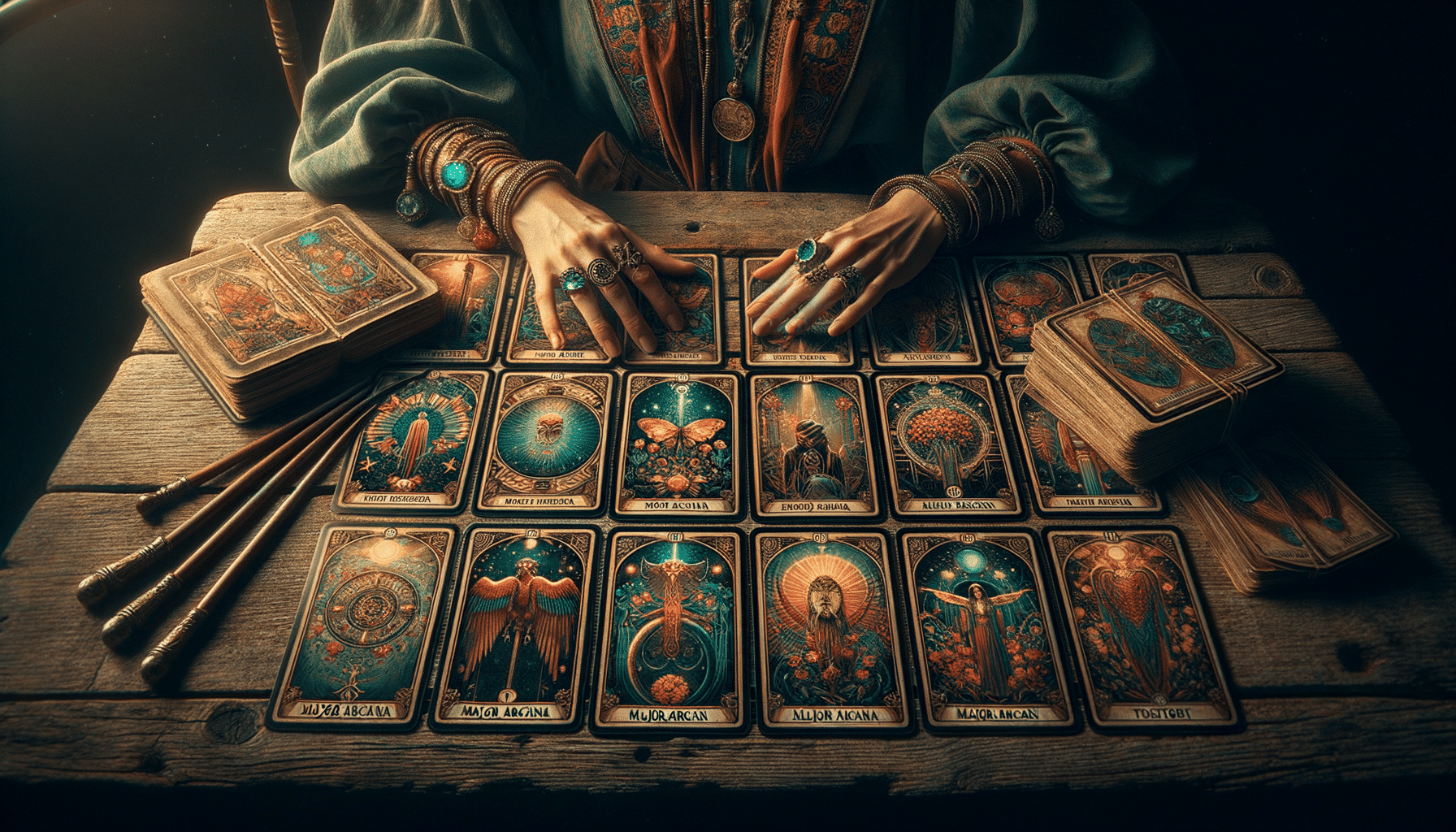
Now, let’s tackle some practical tips to enhance your tarot reading skills.
We’ll explore how to understand tarot card symbols better.
Develop your intuition for more insightful readings.
Avoid common mistakes that can cloud your interpretation.
Grab your deck, and let’s get started.
Understanding Tarot Card Symbols
In your journey to master tarot reading, delving into the symbols on the cards is a critical step you can’t afford to skip. These symbols, laden with rich, intricate meanings, serve as links between you and the universal energies. Mastering their interpretation allows you to tap into profound insights.
Here are some practical tips:
- Dedicate time daily to familiarize yourself with each card. You’ll find that each has unique imagery and symbolism.
- Use a journal to record your impressions and observations.
- Engage in active visualization. Imagine the symbols coming to life and interacting with each other.
With these strategies, you’re on your way to a deeper understanding of tarot.
Next, we’ll explore developing intuition in readings, a crucial aspect of tarot mastery.
Developing Intuition in Readings
As you delve deeper into the realm of tarot reading, honing your intuition becomes an essential step on your path to mastery. This intuitive sense isn’t magical; it’s about tapping into your subconscious knowledge.
Start by setting a calm, quiet environment for your readings. This enables you to focus better and connect with your inner self. Always trust your first instinct when interpreting a card; often, your initial response is the most accurate.
Practice regularly, keeping a journal of your readings and reflections. Over time, you’ll notice patterns and gain confidence in your intuitive skills. Remember, it’s okay to rely on guidebooks, but don’t let them override your intuition.
Now, let’s look at common reading mistakes and how you can avoid them.
Avoiding Common Reading Mistakes
While refining your intuitive skills, you’ll also need to be mindful of common tarot reading pitfalls to truly master the art. Here are some practical tips to enhance your tarot reading skills and avoid typical mistakes:
-
Don’t rush: Tarot reading isn’t a race. Take your time to connect with the cards and interpret their meanings accurately.
-
Avoid preconceived notions: Each reading is unique. Let go of any biases and allow the cards to reveal their messages.
-
Practice mindfulness: Being fully present during readings can greatly improve your connection with the cards.
Frequently Asked Questions
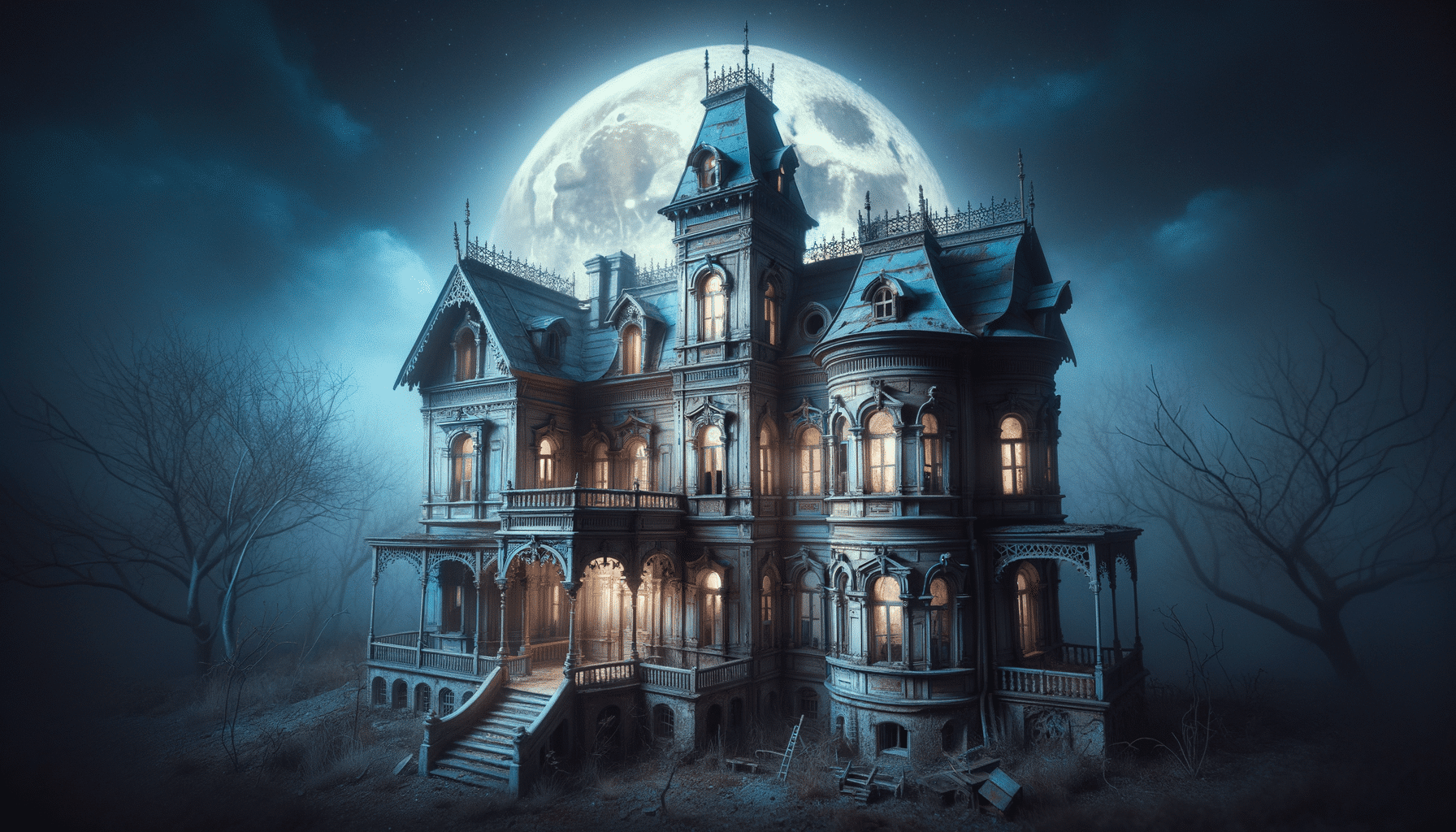
How Can I Cleanse or Consecrate My Tarot Deck Before Using It?
You can cleanse your tarot deck by smudging it with sage, burying it in salt, or leaving it under the moonlight. Consecration involves imbuing it with your energy through meditation or a personal ritual.
Can Tarot Cards Predict Specific Events in the Future?
While tarot cards can’t predict specific future events, they can provide insights into potential outcomes. It’s more about gaining a new perspective than seeing a precise vision of what’s yet to come.
What Are the Ethical Considerations When Reading Tarot for Others?
When reading tarot for others, you’ve got to respect their privacy, avoid making harmful predictions, and ensure you’re not manipulating their choices. It’s about guidance, not control. That’s your ethical responsibility.
Is It Possible to Use Tarot Cards for Meditation or Other Spiritual Practices?
Absolutely, you can use tarot cards for meditation and other spiritual practices. They’re not just for divination. By focusing on a card’s imagery, you’re inviting introspection, aiding your spiritual journey.
Are There Any Famous Personalities Who Have Used Tarot Cards for Guidance in Their Life?
Indeed, many famous personalities have sought guidance through tarot cards. Salvador Dali, a renowned artist, even created his own tarot deck, while singer-songwriter Stevie Nicks openly discusses her daily tarot card rituals.
Conclusion
You’ve navigated the mystic journey of tarot, deciphering symbols, and tuning into intuition.
You’ve explored the immense wisdom of Major Arcana, delved into the subtleties of Minor Arcana.
Remember, tarot isn’t just fortune-telling – it’s a journey into self-understanding.
So keep diving deep, keep learning, and remember: in tarot, as in life, the magic isn’t in the cards themselves – it’s in how you interpret them.
Happy reading!
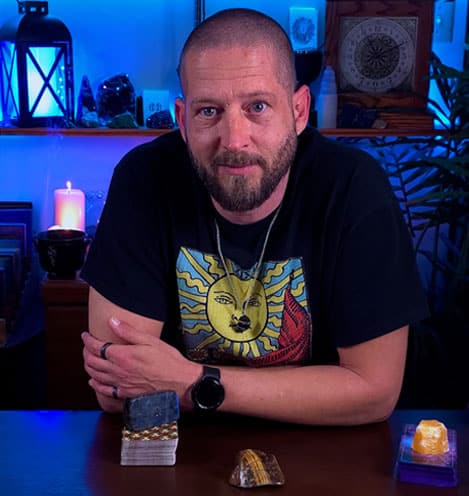
About The Author – Allen Hill
Allen Hill, the force behind Unknown Truth Tarot, has a YouTube following 6-times bigger than the population of his hometown, Miamisburg, Ohio. From his spiritually rich blog on Tarot and crystals to his role as CEO of The Unknown Truth Tarot Metaphysical Shop, Allen’s passion for the metaphysical shines through.
A master Tarot reader and “crystal junkie,” Allen is also a devoted dad to Dylan, 10, and Destiny, 24. When he’s not immersed in the world of Tarot and crystals, he enjoys poker and video gaming sessions, often humorously outplayed by Dylan.
Follow Allen on Twitter, Instagram, Facebook, TikTok, and subscribe to his Unknown Truth Tarot YouTube channel to join him on a journey of spiritual growth and self-discovery.

